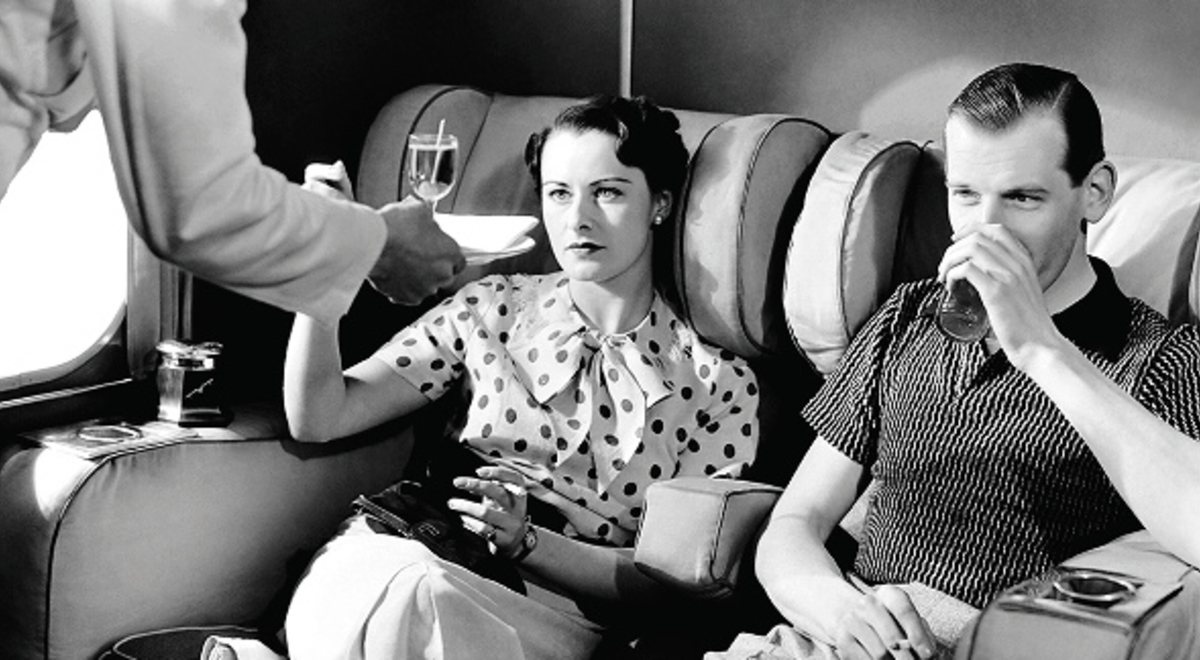
“The past is a foreign country; they do things differently there,” wrote L.P. Hartley, and so it is with air travel.
From the early days of passengers taking to the skies right up until the 1960s, flying was romantic, classy, exciting, something you dreamed about – and very different from today’s experience.
So what was it really like to fly when airport security was a fence, when a silver-service dinner was served on the aircraft and when all baggage was included in the ticket price?
Michael Gebicki takes a look at the flight experience past and present, minus the rose-tinted glasses.
In-Flight Entertainment
Videos of your choice, games, films streamed to your iPad, even the possibility of broadband Wi-Fi on the horizon – the technology passengers now take for granted once belonged to the realms of science fiction.
Even the phrase “in-flight entertainment system” is a relatively new concept that would never have occurred to flyers in days of yore.
Apart from a couple of bold experiments – in 1921 an amphibious plane flew around Chicago with a movie projected on a screen – entertainment was far from what is expected now.

So novel and invigorating was the concept of taking to the air in a giant, shuddering, metal contraption that the flight itself was the entertainment.
Passengers read, chatted, knitted or looked out the window, which was surprisingly pleasurable when aircraft flew at just a few thousand feet.
In the 1940s Pan Am began using projectors to show movies on trans- Atlantic flights. Video-cassettes and drop-down screens came along in the 1970s but if you happened to be short, seated behind a basketball team, or sitting at a lousy angle to the screen, that was just tough luck.
It was not until the advent of the seatback video screen at the tail end of the 1980s that in-flight video systems finally delivered something other than warmed-over family dramas with no naughty bits.
Video on demand with touch-screen technology is now the standard among marquee international carriers.
It’s a big win for travellers, with just one or two downsides. One is putting up with the guy in the next seat laughing out loud while watching The Hangover.
Another is the passenger in the seat behind doing a woodpecker act on the touch screen and jabbing you in the back with every prod.
The Seat
Airline seating started as an afterthought. Wicker armchairs were commonly used to seat passengers on aircraft in the 1920s.
Aircraft interiors went through a purple patch through the 1930s, a time when Britain’s Imperial Airways stitched together far-flung corners of the Empire including a service to Australia.
Photos from the time show chaps lounging in overstuffed armchairs, but the price was stratospheric and the airline industry was realising that its future lay in catering to the masses – and that meant packing more people into the fuselage.

Aluminium-framed seats came in with such venerable aircraft as the Douglas DC-3 in the 1930s and they remain standard, but there’s a world of difference between the then and now of aircraft seating.
While the backrest was once as fat as your granny’s couch, the latest slimline seats are ultra thin, giving airlines more passenger-stacking space.
Seat pitch – the distance between a seat and the same point in the next row – is typically 50 millimetres less on today’s aircraft than on a Boeing 707 of the 1960s, and less still if you are flying aboard a budget carrier.
There is also the passenger load, a factor that colours flyers’ perceptions of cabin space. Airlines have become a lot better at filling seats. Flying economy with an empty seat alongside is not common these days and a full plane contributes to the impression that space is on the small side.

There’s another uncomfortable fact – we are getting bigger. The standard economy airline seat is 43 centimetres wide and while that hasn’t changed since the 1950s, we have.
At the other end of the scale, business and first-class seats aboard a legacy carrier such as Qantas or Emirates outclass the first-class seat of 20 years ago.
Fly long-haul business aboard either and your seat converts to a lie-flat bed, you get a large video screen, noise-cancelling headphones, charger ports, flexible lighting options and privacy.
Top-end seats for use on long-haul international flights can cost an airline $80,000. A first-class suite, complete with double bed, can cost them $500,000.
Aviation milestones
- 1914 - World's first commercial flight
- 1920 - First international air service, between Florida and Cuba
- 1930 - First female flight attendant Ellen Church, hired by Boeing Air
- 1935 - First Qantas overseas flight, Darwin to Singapore, signals beginning of Kangaroo Route
- 1936 - Pan American Airlines inaugurates trans-Pacific passenger flights
- 1938 - Sydney opens its first international airport, the flying-boat base at Rose Bay
- 1952 - First commercial jet flight
- 1969 - Concorde's first commercial flight
- 1970 - Boeing 747 jumbo jet takes to the skies
- 1973 - First female airline pilot, Emily Warner, flies as second officer for Frontier
- 1993 - Ticketless travel available
- 2007 - The first Airbus A380 enters commercial service
- 2013 - Body scanners introduced at Australian airports
Plane English: Please ‘Ex-Plane’ – Your Guide To Travel Terms & Questions Answered
A history of flying. 100 Years Of Flying Infographic
Dress And Decorum
Up until the 1940s, taking a flight was a special occasion, like going to the opera, and you dressed accordingly. It was glamorous, exciting and sexy.
Men were suave, or tried to be, and women flirty, with perhaps just a coquettish hint of fear.
It could be chilly on board so a fur coat was a good idea, and nobody dreamt of taking off their shoes. You were a member of an elite club, and everyone understood the rules.

The era of the well-dressed, well-behaved flyer lasted well into the 1950s. A decade later, when more and more travellers began taking planes, the flying experience became a little less special, and so it could be viewed today.
Now we have stories of air rage, and passengers who flip out, trying to open the emergency exit (impossible, in case you’re wondering). Instagram’s Passenger Shaming page lets you experience the worst without even leaving the ground.
Smoking
In the old days planes, well, stank – and smoking was the reason. Smokers were usually quarantined, but while the aircon system filtered the smoke, it also distributed the smell around the cabin.
On flights to foreign parts you were exposed to the more exotic fragrances the rest of the world sucks into its lungs: clove-scented kretek in Indonesia, Double Happiness in China, Gauloises in France.
If you happened to be a non-smoker seated adjacent to the smoking section, coughing was not optional. There was a culture that went along with smoking.
In the 1930s, some airlines provided complimentary cigarettes. In 1953, United Air Lines began a daily New York-Chicago flight called the New York Executive of which Don Draper would be proud.
The house rules invited men to relax, kick off their shoes and light up a pipe or one of the supplied cigars. Hostesses served steak with baked potatoes and doled out liquor, but apart from them it was men-only. Other women were banned!

In the 1970s, when the Boeing 747 took to the skies, Qantas and a few other airlines used the upper deck as a clubby smoking lounge, with a piano and cocktail waitresses.
The smoke began to clear in the 1980s when the anti-cigarette lobby was gaining traction. By the mid-1990s, airlines around the world were banning smoking.
It was game over in 2000 when President Bill Clinton signed legislation that prohibited smoking on every flight into and out of the US. Well, almost. Amy Winehouse once spent half of a one-hour London-Glasgow flight smoking in the loo, despite entreaties from the crew.
So why do toilet cubicles still sport an ashtray, even on the newest aircraft?
Because if a smoker happens to break the rules, better they stub out in the ashtray rather than tossing it into the waste paper bin. That once started a fire that brought down a Brazilian airliner.
Price
This is one area with plenty to cheer about. In 1935, when Qantas began flying Brisbane-Singapore to connect with Imperial Airways to London, the return fare for the whole trip was $486.
At that time, the average annual wage for a Victorian manager was $364. It would have taken that manager 70 weeks to earn enough to fly return to the UK. In reality, that manager never flew to London, since only the wealthy and privileged could afford it. At the same time, the average Melbourne house cost $610, a lot less than the price of two return tickets to London.

Today, it takes the average Australian worker just under seven days to earn enough to buy a return economy-class ticket from Brisbane, or any other capital city, to London. Efficiency, technology, competition and deregulation have all been good news for flyers.
At a press conference in the mid-1980s, Colin Marshall, CEO of British Airways, announced a return Sydney-London airfare of $1,300.
At the time it was an audacious gambit, a masterstroke designed to nuke the competition. Thirty years later, the cheapest discount fare on the same route is not much more, yet the average wage is now more than three times higher – which makes air travel an all-time bargain.
Next time the meal trolley rumbles down the aisle in economy, and the flight attendant presents you with a less-than-gourmet meal, you might ponder your very good fortune.


